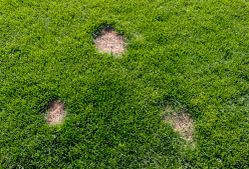3 Common Lawn Pests & How to Identify Them

Aside from watering, mowing, and fertilizing your lawn, one of the primary challenges to keeping it healthy is dealing with pests. If you’re unfamiliar with lawn pests, they can cause a great deal of damage, and it often requires a reliable lawn care professional to eradicate them. Below are some of the most common types of lawn pests and how to identify them.
How to Identify Common Lawn Pests
1. Sod Webworms
Sod webworms are the larvae of the crambus moth. They primarily feed on turf grasses, though they are also known to eat corn, wheat, rye, oats, and timothy grass. They are typically gray, green, or beige and grow to half an inch long. Sod webworms appear in June and last until late July when they mature into adult moths. They are nocturnal and are therefore difficult to spot. You'll know them by the damage they cause. They devour the soft tissue of the grass and leave the veiny stalk, so patches of grass turn brownish-yellow. If you suspect sod webworms on your lawn, contact a lawn care professional for assistance.
2. Grubs
 Grubs are the larvae of the scarab beetle. Upon exiting their eggs in mid-to-late summer, they become voracious feeders, feasting on grass roots until early or mid-fall. They are fat, white, C-shaped, and the damage they cause in fall may not show up until the following spring. Patches of grass may remain brown and lifeless and never turn green. You may also notice brown spots forming in autumn. Additionally, they attract birds, skunks, raccoons, and moles, who feed on them. Unusually high activity with these animals could indicate a grub infestation.
Grubs are the larvae of the scarab beetle. Upon exiting their eggs in mid-to-late summer, they become voracious feeders, feasting on grass roots until early or mid-fall. They are fat, white, C-shaped, and the damage they cause in fall may not show up until the following spring. Patches of grass may remain brown and lifeless and never turn green. You may also notice brown spots forming in autumn. Additionally, they attract birds, skunks, raccoons, and moles, who feed on them. Unusually high activity with these animals could indicate a grub infestation.
3. Armyworms
Armyworms are the larval stage of the true armyworm moth. They are agricultural pests common to North and South America. They feed on weedy grasses and other crops, including grains, beans, cabbage, celery, and carrots. They reach 1½ to 2 inches long and have green, red, brown, or yellow stripes with a distinctive inverted ‘Y’ mark on the head. They may chew the grass blades to the ground, leaving bare patches, or simply leave the blades looking ragged and brown. They feed around the clock but are most active during early morning and late evening.
For expert lawn care to rid your yard of pests, contact Going Green Lawn Services, an experienced landscape contractor in Fenton, MO. They are family-owned and -operated and have served St. Louis County for more than a decade. They specialize in all areas of lawn care, including weed control, irrigation, and fertilization. You can learn more about their services on their website or call (636) 388-2883 to schedule a consultation.
About the Business
(3 reviews)
Have a question? Ask the experts!
Send your question

